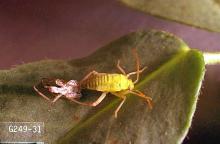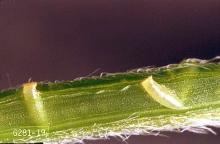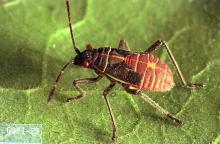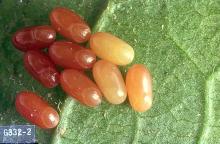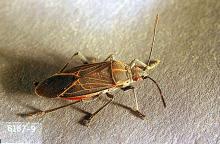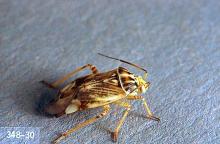Brown marmorated stink bug (Halyomorpha halys)
Consperse stink bug (Euschistus conspersus)
Western boxelder bug (Boisea rubrolineata)
Western tarnished plant bug (Lygus hesperus) and other Lygus spp.
Pest description and crop damage Adult stink bugs are all shield-shaped, with a triangle-shaped section in the middle of their backs. They are generally up to about 0.5 to 0.6 inch long. The name "stink bug" refers to the strong odor that the insects can emit if alarmed or harmed. The consperse stink bug is pale brown, yellow on the underside and has red antennae. Brown marmorated stink bugs (BMSB) are brown, resembling tree bark, and have white bands on their antennae. The western boxelder bug is about 0.5 inch long and one-third as wide. Adults are mostly black and have three red lines on the pronotum of the thorax (one down the center) and several fine red lines on each wing. The wings lie flat on the bug's back when it is at rest. The abdomen is red. The young nymphs are bright red and when about half-grown become marked with black and begin to develop black wing pads. Adult lygus bugs are oval, about 0.2 inch long with a light yellow 'V' on the back. The bugs feed on developing leaves, flowers, and fruit, which kills the tissue around the feeding site. They pierce and damage fruit with their mouthparts which leads to fruit "catfacing" later in the season.
Biology and life history Adults overwinter in groundcover. They feed early in the season on weeds and may move later into other host plants. Stink bug damage is worse in dry summers when alternative hosts dry up sooner in the season.
Management-cultural control
Eliminate weeds that serve as protection and food for bugs early in the season.
Management-chemical control: HOME USE
Warning: Many pesticides are hazardous to bees. Look for bee precautionary statements on product labels and do not use these products during bloom or if bees are foraging in the orchard.
- azadirachtin (neem oil)-Some formulations are OMRI-listed for organic use.
- carbaryl-Highly toxic to bees.
- gamma-cyhalothrin-Highly toxic to bees.
- kaolin-Applied as a spray to leaves, stems, and fruit, it acts as a repellant to some insect pests. Some formulations are OMRI-listed for organic use.
- lambda-cyhalothrin-Highly toxic to bees. Stink bug only.
- pyrethrins (often as a mix with other ingredients)-Highly toxic to bees. Some formulations are OMRI-listed for organic use.
- zeta-cypermethrin-Highly toxic to bees.
Management-chemical control: COMMERCIAL USE
Prebloom spray
- esfenvalerate (Asana XL) at 5 to 14 fl oz/A. REI 12 hr. Extremely toxic to fish and aquatic invertebrates; avoid spray drift and runoff to surface waters.
- lambda-cyhalothrin (Warrior II) at 1.28 to 2.56 fl oz/A. REI 24 hr. May disrupt beneficial mite populations. Extremely toxic to fish; avoid spray drift and surface runoff.
Spring and summer spray
- esfenvalerate (Asana XL) at 5 to 14 fl oz/A. REI 12 hr. PHI 14 days. Extremely toxic to fish and aquatic invertebrates; avoid spray drift and runoff to surface waters.
- lambda-cyhalothrin (Warrior II) at 1.28 to 2.56 fl oz/A. REI 24 hr. PHI 14 days. May disrupt beneficial mite populations. Extremely toxic to fish; avoid spray drift and surface runoff.
- thiamethoxam+chlorantraniliprole (Voliam Flexi) at 6 to 7 oz/A. Do not apply exceed 14 oz/A of Voliam Flexi per season. REI 12 hr. PHI 14 days.
See also, in this Handbook:
Brown Marmorated Stink Bug: An Emerging Threat to Pacific Northwest Agriculture
For more information
Brown Marmorated Stink Bug (https://catalog.extension.oregonstate.edu/em9054)
Brown Marmorated Stink Bug (https://treefruit.wsu.edu/crop-protection/opm/brown-marmorated-stink-bug)

